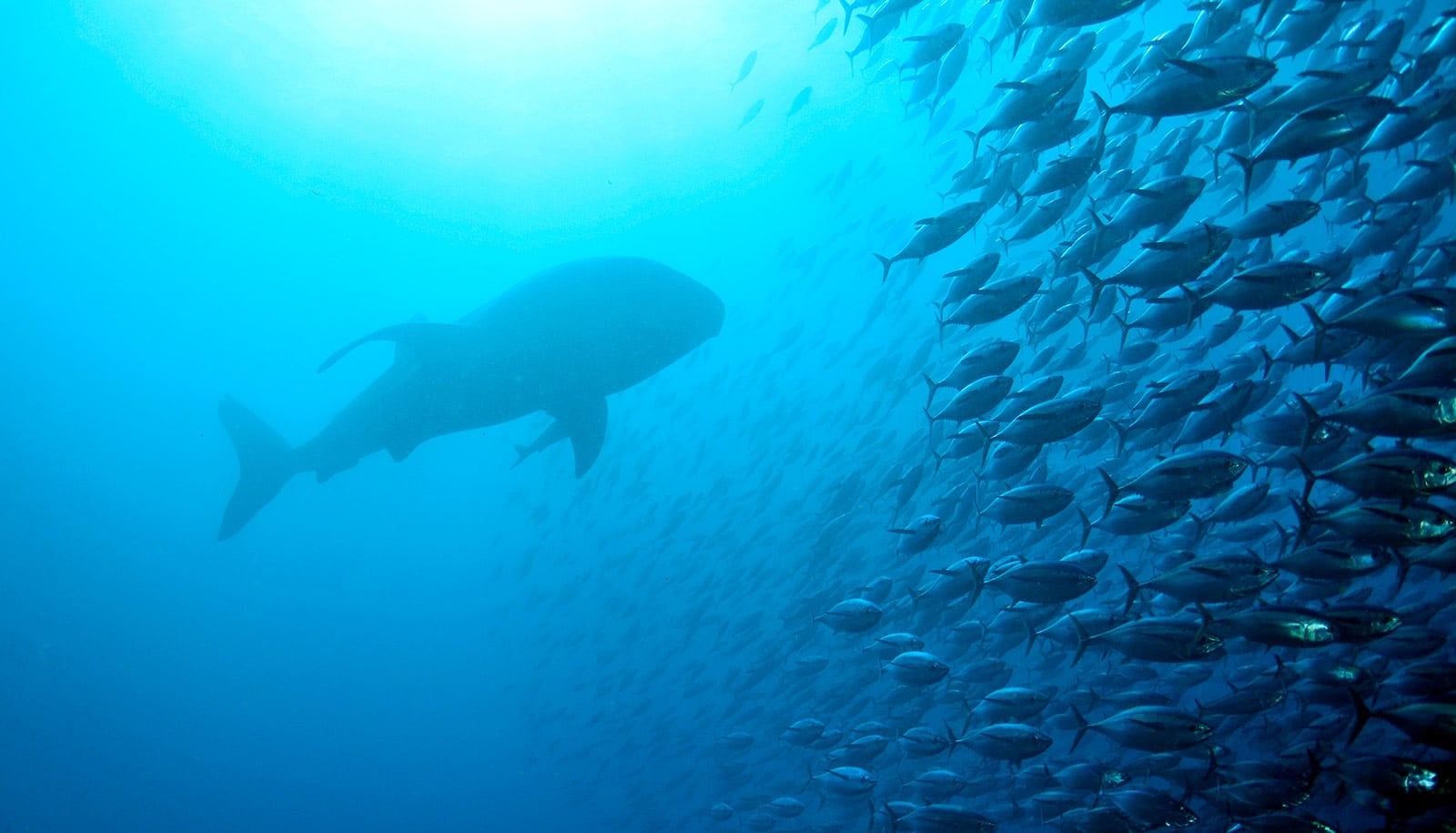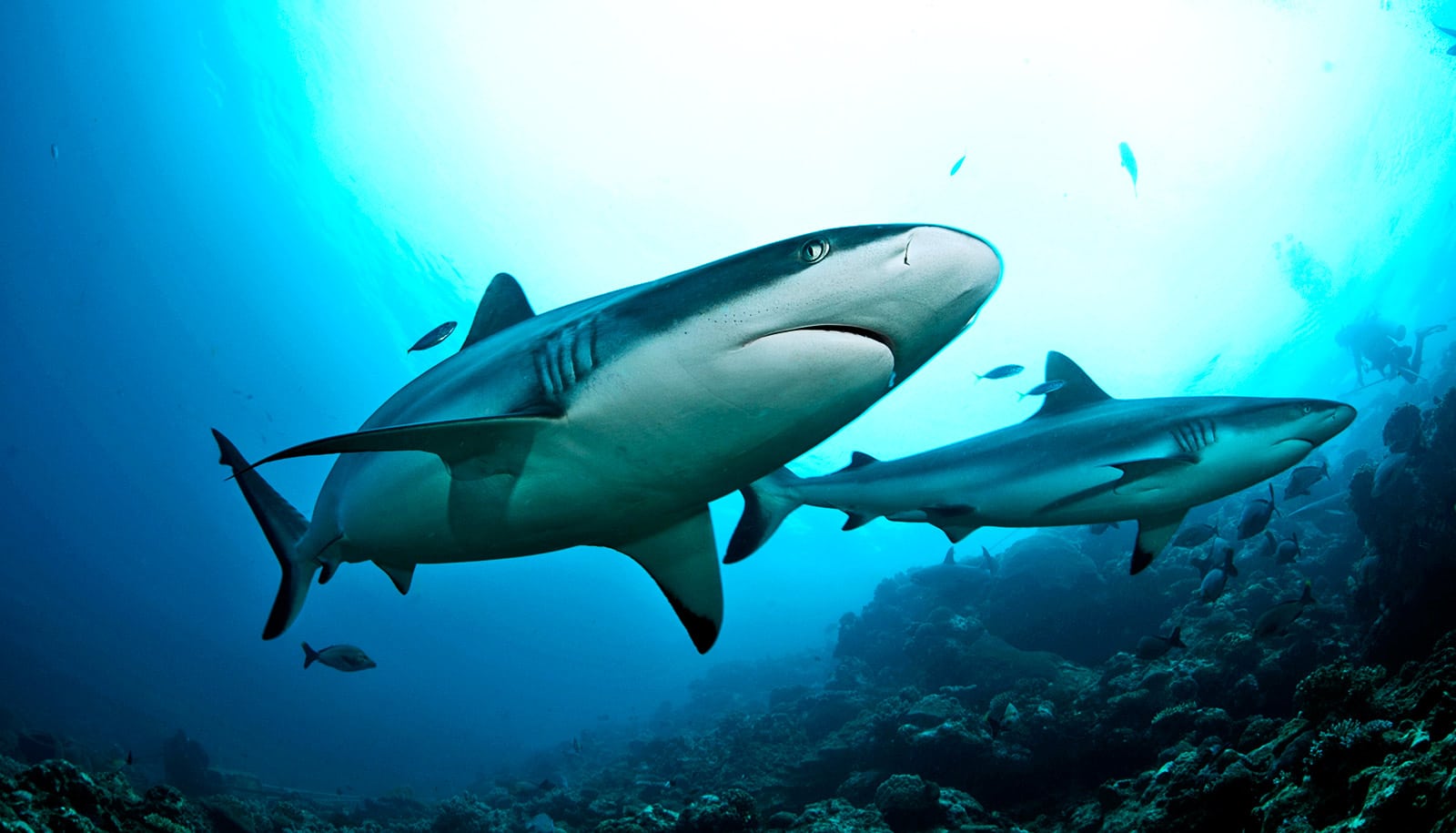Researchers are using machine learning to map where sharks face the most risk from longline fishing.
The ocean can be a dangerous place, even for a shark. Despite sitting at the top of the food chain, these predators are now reeling from destructive human activities like overfishing, pollution, and climate change.
The new research used data from regional fisheries management organizations and machine learning algorithms. The findings in Frontiers in Marine Science highlight key regions where sharks can be protected with minimal impact on tuna fisheries.
Sharks take the bait
Offshore longline fisheries take an especially heavy toll on ocean life. The non-selective technique has the highest rate of shark bycatch.
“Longline fishing gear is exactly what it sounds like: a long line with lots of hooks attached to it that are baited. And they can be left in the water, waiting for fish to bite, for a very long time,” explains co-lead author Darcy Bradley, who heads the Ocean & Fisheries Program at the Environmental Markets Lab (emLab) at the University of California, Santa Barbara.
These baited hooks catch predators like tuna, but many nearby sharks will also converge on the bait.
Rather than simply report how many sharks were caught and where, the authors aimed to assess the relative risk sharks faced across different areas of the ocean.
“One of the main questions was ‘Where is the risk for catching sharks the highest, and does that overlap with fishing effort?'” says co-lead author Echelle Burns, a project scientist at emLab.
To answer this, Burns, Bradley, and coauthor Lennon Thomas (also at emLab) went hunting for data on longline fisheries. They sourced publicly available data from tuna regional fisheries management organizations. These intergovernmental institutions manage, collect data, and perform scientific assessments for tuna and tuna-like species.
The authors compiled data on shark catch from industrial longline fishing across all the world’s tuna fisheries into one comprehensive resource. This was quite a task. Each fisheries management organization operates differently, meaning their data isn’t always in the same format.
“Now anyone who’s interested in shark catches and other happenings in these global longline fisheries has access to that information,” Bradley says.
Even top predators face risks
The authors paired spatial shark catch data with environmental data like sea-surface temperature and factors correlated with food abundance. They also included economic data like ex vessel price—the price that fishers receive directly for their catch—for different shark species each year.
“Because you can’t catch a shark where it doesn’t live,” Bradley adds, “we used species distribution models to delineate where different sharks actually live in the ocean to inform our risk assessment.”
Still, there were a lot of unknowns. Not every fishing vessel has an impartial observer recording catch for the fisheries management organizations. And not every report is completely accurate.
So Burns, Bradley, and Thomas used a model to fill in the gaps, recognize trends and draw conclusions from this incomplete data. “The whole reason to use a model is because we have imperfect data,” Bradley says. “If we knew everything we wouldn’t need a model.”
This was a new approach to estimating the interactions between fisheries and marine species. Using machine learning enabled the team to extrapolate trends from their messy datasets. First, the model assessed whether a shark species was present in an area, and if so, how likely it was to be caught there. Then it looked at how many sharks of each species were caught in an area.
The authors prioritized predictive power in this study. “Our goal was to identify where sharks are at the highest risk of being caught by tuna longline fisheries,” Bradley explains. “For this study, we were not trying to understand the extent to which various factors influence this risk.”
The authors used a random forest model, which combines the outputs of many decision trees. Each decision tree considers a different variable, and its outcome is a vote for the final prediction.
“The basic idea is that a bunch of poor decision-makers, the trees, can share information to ultimately make a better decision: the forest,” Bradley says. While this method doesn’t provide a clear picture of how each factor influences the system, it is very good at making sense of messy and incomplete datasets. What emerged was a map of catch risk for shark populations across the globe.
Good for sharks, good for fishers
Tunas and sharks are both predators and target similar prey, so they’re often found together. But while they may share some traits, sharks and tunas are fundamentally different types of animals. Tunas grow quickly and produce many offspring, while sharks mature relatively late and reproduce slowly.
As a result, tuna can withstand much higher fishing pressures than sharks, and even a small impact on shark numbers can affect the population of a threatened species.
Fortunately, the scientists found that hotspots for longline-shark interactions didn’t correspond with preferred fishing grounds. “This suggests that we can design management strategies that can protect vulnerable and threatened shark species without having to close the most productive tuna fishing grounds,” Bradley says. The team found this particularly heartening, since it could encourage actions that help sharks while appealing to fishers as well.
Shark catch hotspots
The difference between hotspots and good fishing grounds could stem from those differences between tuna and sharks.
“For example, we noticed that some of the shark catch hotspots overlap with areas that play a critical role in a shark’s life cycle,” Thomas says. Take the ocean off the coast of Namibia, a well-known nursery habitat and juvenile feeding ground for blue sharks.
In fact, blue sharks dominated interactions with longline fishing fleets. This common and widespread species contributed over 78% of the total shark catch reported by tuna regional fisheries management organizations between 2012 and 2020.
As a result, the majority of the paper’s findings for sharks as a whole are driven by blue shark catch in particular. This was one reason the authors investigated hotspots for 12 species individually in their supplementary materials.
The team is working on a follow-up study estimating global shark mortality due to fishing as a whole—not just longline. They also plan to assess whether regulations have helped prevent shark catch. What’s more, this paper’s random forest model can provide insights on other species threatened by overfishing.
Better data will allow the team to improve their model, but it’s already providing useful lessons. For instance, we can design management strategies to protect vulnerable and threatened shark species without disrupting prime tuna fishing grounds.
“Making small adjustments to tuna fishing regulations to avoid shark catch hotspots could make a huge difference for shark populations in the future,” Burns says, “while also ensuring that the tuna fisheries remain successful.”
Source: UC Santa Barbara



